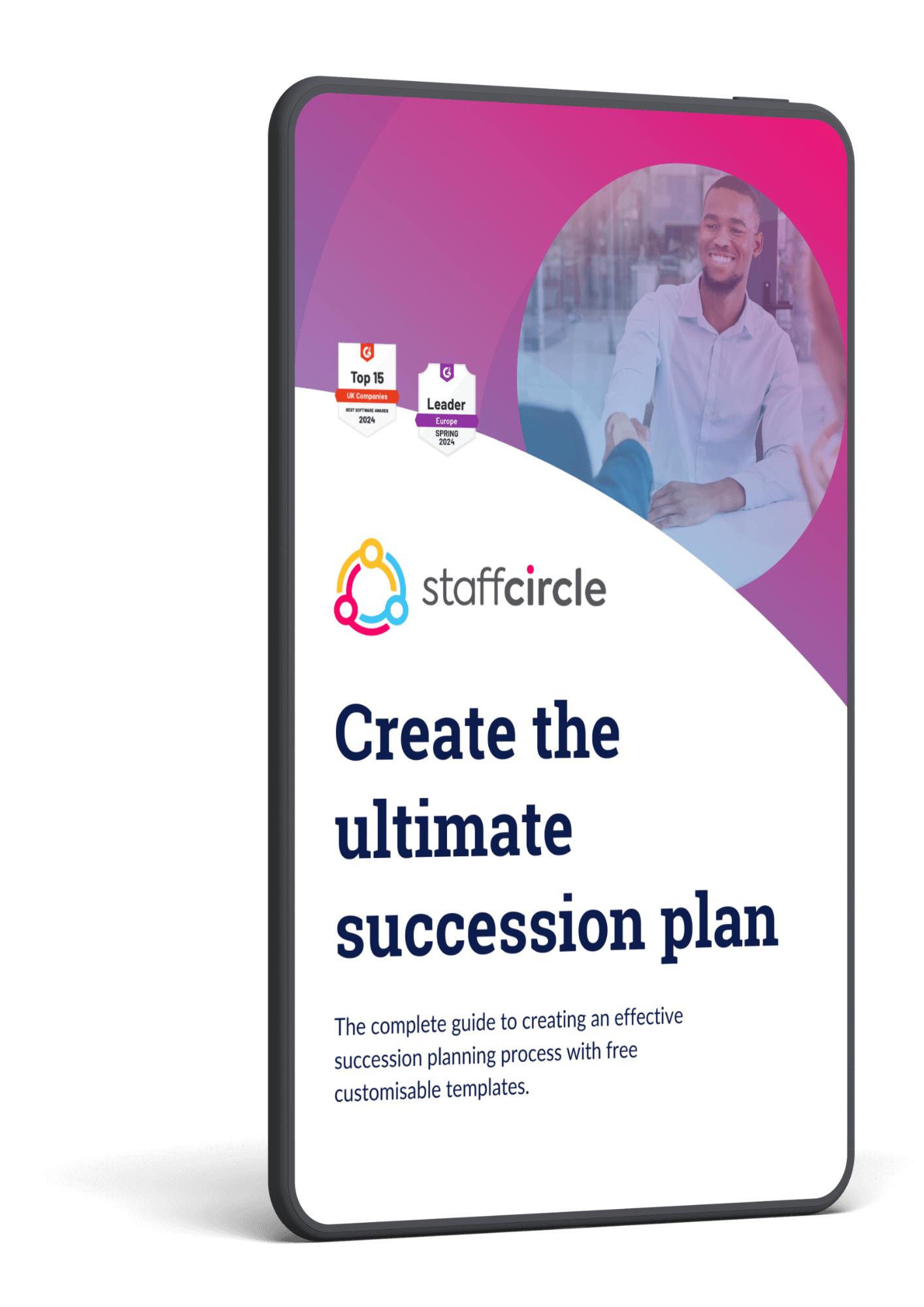Struggling with succession planning?
We understand that succession planning can cause HR teams headaches.
Not knowing how to identify your top performers, the right questions to ask, or how to personalise individuals career development are all barriers HR leaders experience.
Whether you’re just starting your succession planning or just want to improve your processes, our guide to creating an effective succession plan is here to help.
StaffCircle customers see up to 90% less performance admin and 74% improved employee engagement.
Thinking of joining them? Click here to tour StaffCircle’s succession planning tools.
It’s time to rid the bias, ditch the grid, and embrace the circle.
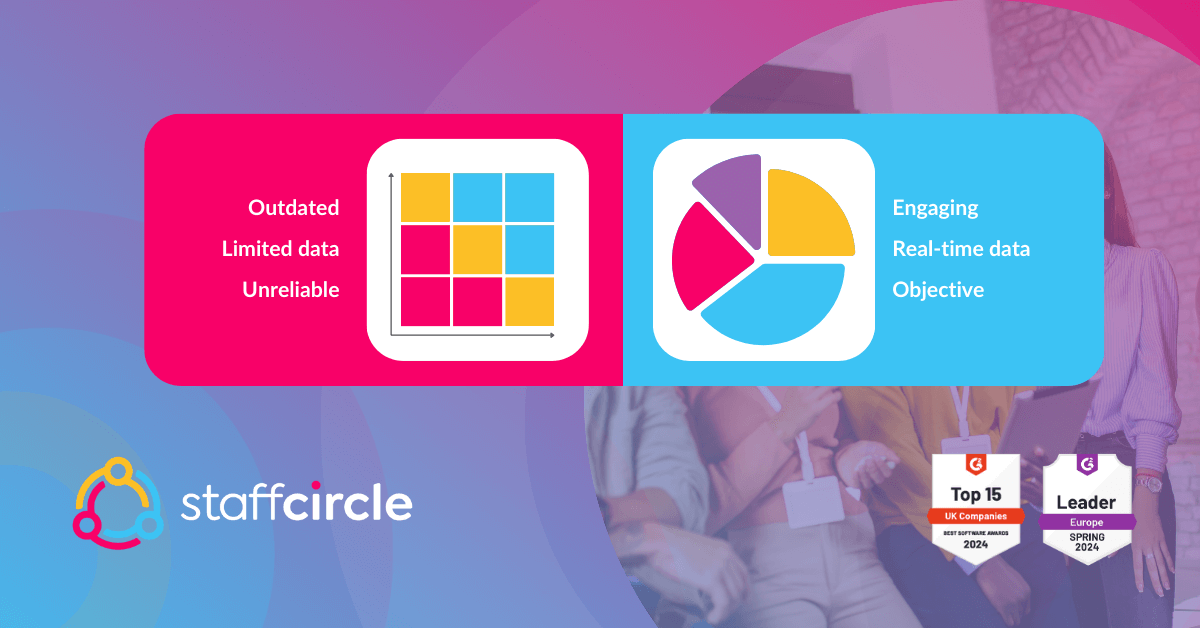
What is succession planning?
The aim of an effective succession plan is to identify, nurture and support growing talent into performing business-critical positions.
In a nutshell, it’s all about:
Understanding which roles are crucial for your business’ success
Finding internal talent that could one day step into these positions
Nurturing their development to help them perform these roles
Succession management takes this concept further by offering a holistic and long-term approach to building a leadership map and developing talent benches for key roles, ensuring the continuity and success of the organization through strategic talent and leadership development.
Traditionally, succession planning was done with tools such as the 9 box grid.
It was invented way back in the ‘70s. As you can imagine, it’s pretty outdated.
It helps leaders visualise their workforce’s strengths and weaknesses in nine separate categories:

However, it only focuses on employee performance.
In 2025, we know that high performance isn’t the only thing that contributes to a great leader.
In fact, often it’s the complete opposite.
High performers can be skilled at their roles, but not equipped with the cultural know-how to effectively manage and lead a team.
The secret sauce of modern succession planning
So what’s the solution?
Recognising the potential of every employee as an individual.
Assessing performance based on individual strengths
Understanding how core value alignment impacts their relationships with other team members
Creating individualised development plans that suit their potential
Sounds difficult, right?
We’ve supported companies like yours create better succession plans.
And we’re here to help you too.
We’ve put together the guide to creating the ultimate succession plan. And you can download it today for free.
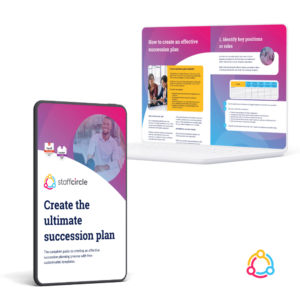
How to automate the succession planning process
Of course, the StaffCircle platform helps leaders digitalise processes to create better workforces.
And this extends to succession planning.
In our ultimate guide, we walk you through each of the steps you can take to improve your succession planning process.
And they can all be done manually, using the handy spreadsheet template we’ve provided.
But StaffCircle can make it simpler.
Our fully automated platform digitises the whole succession planning process.
With our succession planning dashboard, skills gap analysis and personalised development plans, StaffCircle makes creating an effective succession plan achievable and measurable.
Want to see how it works?
Book a demo with one of our experts today!

Visualise employee potential with Success Circles
Success Circles were created as a new, innovative way to support your succession planning.
Designed to help you nurture the growth and development of your employees, unlocking their full potential by:
- Helping you identify high-performers and potential successors
- Enabling you to create personal development roadmaps for employees
- Aiding you in understanding performance barriers and highlighting skills gaps
- Empowering you to take fast action to support underperforming employees
Say goodbye to the limitation of the 9-box grid and hello to effective, engaging career development for your employees.
Structuring an effective succession planning strategy
There is no ‘one-size-fits-all’ approach to succession planning, including the critical component of replacement planning. This process is essential for the strategic development of a talent pipeline for key roles within your organization. It ensures business continuity, talent retention, and the achievement of long-term organisational goals by identifying and developing internal candidates to fill critical positions.
The structure of your succession plan will end up being unique to your company.
However, there are some key steps that should be included in every succession planning framework to deliver optimal results.
- Identify key positions or roles
- Understand core skills for critical roles
- Pinpoint future leaders and high-potential talent
- Explore career development requirements
- Introduce personalised development plans
- Measure succession plan strategy progress
Talent management is an ongoing process, and succession planning is something that needs continuous work.
So rather than a linear approach, we recommend looking at the key steps as part of a cycle.
The steps provided in this guide cover every area of the cycle. They allow you to build a unique succession planning strategy that evolves over time.
The 9 box grid just doesn’t cut it anymore. It’s time to ditch the grid and embrace the circle.
Am I ready for succession planning?
Implementing a new process is difficult. We get it.
Understanding whether you’re ready or not can often seem like a flip of the coin.
It’s up to you to decide whether to prioritise the time, effort and budget on a process you’re not sure will work.
The good news?
You can implement a successful succession planning process by downloading our guide and template.
The even better news?
You can make succession planning even simpler with StaffCircle.
Our automated development and succession planning tools help you map out key positions, leadership development and future roles for candidates of all levels.
The ultimate succession planning checklist
Before you start strategising your succession planning process, it’s important to understand what’s involved.
What makes a great succession plan?
With our customers, we’ve seen a lot of different styles of succession plans. And the best ones have a few distinct points in common.
In our opinion, here’s what you need to create an effective succession planning process.
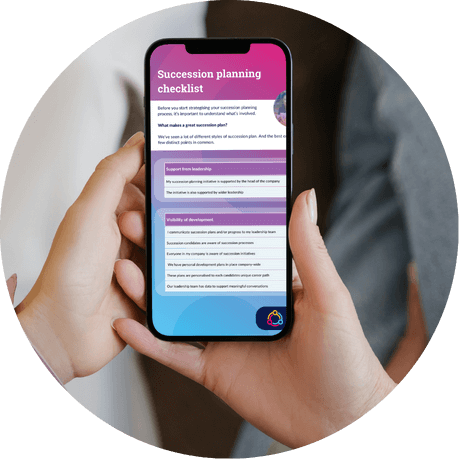
Support from leadership
- Your succession planning initiative is supported by the head of your company
- It’s also supported by wider leadership
Visibility of development
- You communicate succession plans and/or progress to your leadership team
- Succession candidates are aware of succession processes
- Everyone in your company is aware of succession initiatives
- You have personal development plans in place company-wide
- These development plans are personalised to each candidate’s unique career path
- Your leadership team has data to support meaningful conversations about candidate readiness
Effective development and succession tracking
- You document succession-related discussions and plans
- Your leadership team is involved in formally evaluating succession plans
- Succession plans are updated regularly
- Succession plans can be viewed in real time to gain a clear picture of current standings
It sounds like a lot of steps, we realise.
But that’s where StaffCircle is here to support you.
Customers using StaffCircle for better succession planning say ‘yes!’ to each step of the checklist.
And they aren’t stuck using time-consuming, paper-based processes.
They use StaffCircle’s automated development tools to create the ultimate succession planning process.
1. Identify key positions or roles
An effective succession plan is your way to ensure business continuity.
So, the first step is to understand which roles are key to your company’s operations.
To identify business critical roles that are crucial to operational activities and strategic objectives. Positions that, if left vacant, would make it difficult to continue day-to-day operations and would prevent you from achieving business goals.
Rather than plucking job roles at random, you need to take a critical and data-based view of all roles.
You need to rate roles depending on a series of metrics:
- Priority
- Consequence
- Specialist
- Internal
- External
To accurately determine these key roles, rank each of these criteria using the template.
When you’re finished, you’ll understand the priorities for your succession planning process.

2. Understand core skills for critical roles
Your next step is to understand what it takes to perform these key roles successfully.
Every role in your company requires its own set of skills. A depth of experience. Specific training courses.
Understanding and collating this information is key.
To gather it, you need to speak with the current holder, their manager and direct reports. The more details the better.
You need to assess what is important at present and for the future.
But how do you keep it organised and informative?
You’ve got two options.
- Use our template to complete this task manually
- Use StaffCircle to automatically assign skills to individual roles
Both options create better succession planning opportunities.
The difference is the amount of time you’ll need to invest to keep this information current.
Want to understand how automated succession plan software works?
Book a demo with one of our experts and tour the StaffCircle platform.

3. Pinpoint future leaders and high-potential talent
Next up is to identify who has potential for future leadership roles.
Getting to know your talent pool and nurturing an ever-evolving network of internal candidates.
You need to look across every function in your company and establish a set of measurable criteria that you can use to evaluate overall candidate readiness.
One of the benefits of succession planning is that it allows you to get to know your workforce better.
To understand who has the ambition to progress, who requires leadership development and who is happy in their current role, but could use more training.
However tracking this manually, in real-time, can be difficult.
That’s where employee development software can support your succession planning process.
Our template helps you start the process manually, but using the StaffCircle platform helps you to perfect it.

4. Explore career development requirements
Next up?
Planning how you’re going to help each of these key employees meet their potential.
You need to objectively measure and assess your team’s development needs.
The best way to do this is through 360 feedback and regular performance reviews.
Struggling to get this set up? Our ultimate guide to creating an effective succession plan has the template you need to explore this. Or you could use 360 feedback software.
But the key here is to compare the results of these reviews with the critical role analysis you carried out in Step 2.
This will help you to highlight any competency or skill gaps in your current workforce.
It’s time to start thinking about the bigger picture and pulling together overviews of each candidate and the skills they need to develop to progress.

5. Introduce personalised development plans
Once you’ve established where the skills gaps are, it’s time to address them.
Often, developing talent is given a ‘one size fits all’ approach.
This rarely works.
Instead, you need to craft individualised development plans that suit each of your employees.
Struggling to know where to start?
We’ve included a full personal development plan template in this ultimate guide!
It’ll help you focus on skill improvements, measurable deliverables and how to review progress.
You’ll be able to organise coaching, mentoring, experience or training required to help your top talent achieve their goals and help your company ensure business continuity.

6. Measure succession plan strategy progress
Finally, you need to measure your progress and evaluate its effectiveness.
It’s critical that your succession plan aligns with your company’s overall objectives.
This means that when you measure success, you need to use metrics that reflect your unique aims.
It’s important to collect data throughout the process to make sure your strategies are working.
Metrics involved in reporting on succession planning include:
- Turnover rates
- % of positions filled internally
- Recruitment costs
- Employee engagement
If you use the templates included in our downloadable guide, you’ll be able to manually track your progress.
Want to make it easier?
StaffCircle automatically collects and collates all of the data gathered in your succession planning process and then displays it in accessible dashboards.
All your succession planning progress is tracked and visible.

How does StaffCircle support better talent management?
How do you currently identify your top performers, development requirements and future leaders?
If you’re like many other HR leaders, it’s probably using the 9-box grid.
And whilst the three-by-three matrix has worked for the past 40 years, we’ve got something better.
Introducing Success Circles.
The new, innovative way to review every completed objective, every piece of feedback and every award given. Automatically creating a full performance overview, you can use to aid your success planning.
We’re here to make 100% of leaders successful in succession planning.
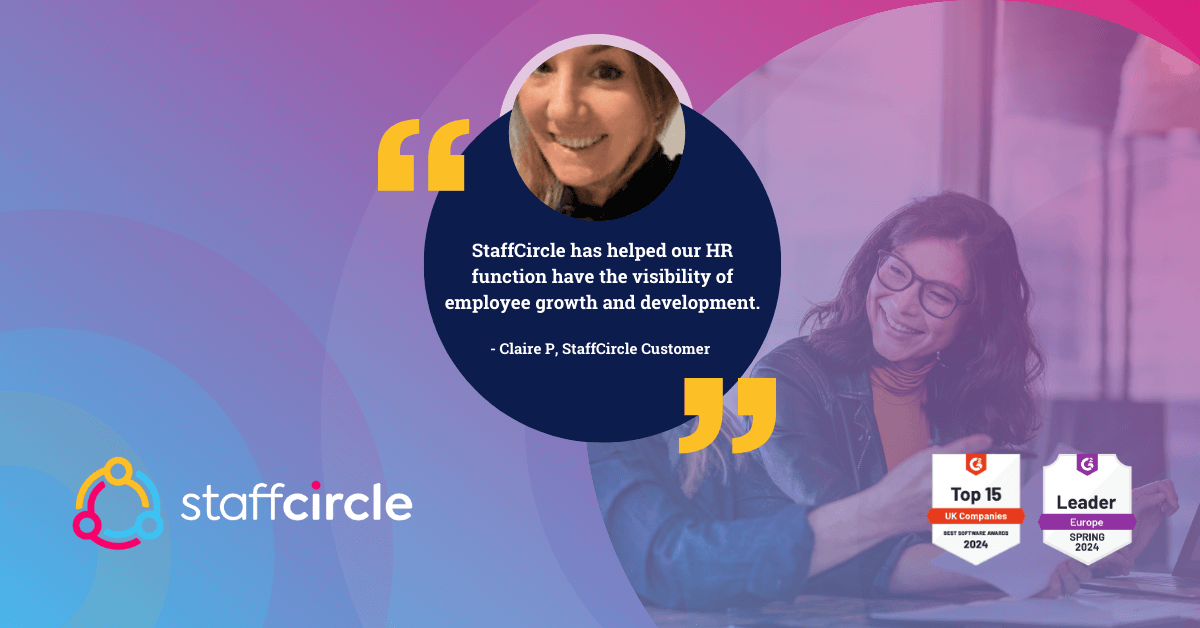
Creating a succession plan FAQs
What are the main reasons employees leave, and how does succession planning address them?
Lack of progression opportunities is a leading cause of employee turnover. Succession planning directly tackles this issue by identifying and nurturing internal talent, providing clear paths for career advancement, and ensuring a smooth transition of leadership roles, ultimately improving employee retention.
How does succession planning benefit businesses, particularly in terms of workforce performance and engagement?
Succession planning unlocks a high-performing workforce by creating opportunities for internal talent to grow and succeed. Studies show that companies with effective succession plans experience up to 90% less performance admin and a 74% increase in employee engagement, leading to improved overall organisational performance.
What outdated tools are commonly used in succession planning, and why are they ineffective in today’s landscape?
Traditional tools like the 9-box grid, invented in the ’70s, are outdated and limited in their effectiveness. While they focus solely on employee performance, modern succession planning requires a more holistic approach that considers individual strengths, core value alignment, and potential for leadership, as highlighted by the innovative Success Circles introduced in our guide.
How can I identify key positions and high-potential talent within my organization to kick-start the succession planning process?
The first step in effective succession planning is identifying key roles crucial for your business’ success. Our guide provides a detailed template and methodology to assess and rank positions based on priority, consequence, specialisation, and other metrics, enabling you to pinpoint future leaders and high-potential talent.
What are the essential steps in structuring an effective succession planning strategy, and how can I ensure its success?
Structuring an effective succession planning strategy involves several key steps, including identifying key positions, understanding core skills required, pinpointing future leaders, exploring career development requirements, introducing personalised development plans, and measuring progress. Our guide offers detailed insights and practical templates to help you navigate each step and ensure the success of your succession planning efforts.
